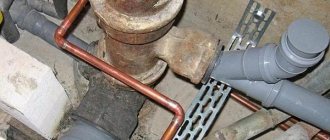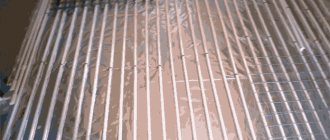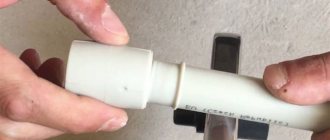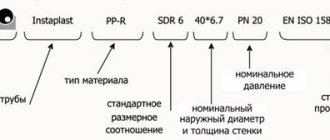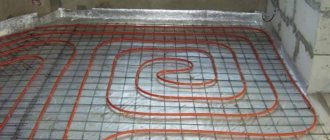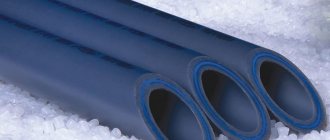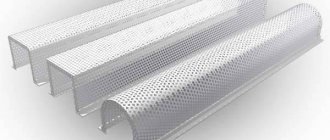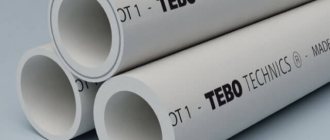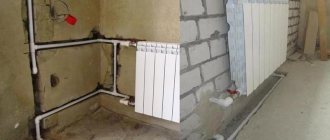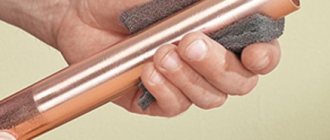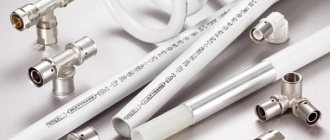In almost any residential building or city apartment you can always find water heating systems. These are mainly centralized or autonomous heating systems, double-circuit or single-circuit, the difference is in power, in details and in the tasks assigned. However, one technological aspect remains common to all - the liquid type. The main work of delivering heat to heating devices is performed by boiler water or antifreeze.
The coolant circulates through the circuit, which is the “circulatory system” of heating. The quality of the pipes and the material of manufacture determine the permeability of the pipelines and the service life of the pipeline. Today, new technologies in the field of heating equipment have also affected consumables, bringing to the fore reinforced polypropylene pipes used for heating systems. These products appeared relatively recently, but have already managed to gain wide popularity among consumers. What is the reason for such success of synthetic products, what advantages do polypropylene pipes reinforced with fiberglass or aluminum have?
Main article about polypropylene pipes.
Reinforcement of polypropylene pipes - the main goal and objectives
We well remember the metal pipelines in our apartments or private houses through which hot water gurgles, supplying home radiators with the desired warmth. There is no need to talk about the attractive appearance of such highways, especially since over time the permeability of metal highways significantly deteriorates. Poor quality coolant and frequent blockages cause a decrease in the functionality of metal heating circuits. Consequently, over time, the quality of heating of residential premises sharply deteriorates.
In most cases, these factors are the reason why synthetic materials appeared on the market for heating consumables. First, metal-plastic pipes appeared, and a little later polypropylene consumables began to enter the market. High performance characteristics, technological parameters and affordable prices have made synthetics the most common components for heating systems today. Attempts to improve the technological parameters and characteristics of polypropylene led to the decision to reinforce polypropylene.
Reinforcement is a technology as a result of which the structure of the base material is supplemented with reinforcing components. By incorporating an additional inner layer into the polypropylene structure, the linear rigidity of the pipe is significantly increased, and the strength and stability of the material increases. The reinforcing layer plays a key role, significantly reducing the coefficient of thermal expansion of synthetic pipelines. Unlike conventional polypropylene, a reinforced polypropylene pipe is 5 times less susceptible to thermal elongation, which has a positive effect on the appearance of the pipeline and its functional parameters.
For reference:
in a home heating system, the temperature of the coolant in the circuit is 50-700C. In the case of autonomous heating, the temperature of the coolant can periodically rise to a critical level of 950C. The operation of a non-reinforced polymer pipe at such temperatures has an extremely negative impact on the physical properties of its material of manufacture.
For home heating, when a significant part of the heating circuit lies outside and is clearly visible, using a conventional polyethylene pipeline is impractical. You will have to constantly solve the problem of sagging lines by installing additional fasteners and clamps. Which product is best to choose for the heating circuit is the next question, which should be considered in more detail.
Polypropylene pipes and their features
Polypropylene pipes have many advantages, among which are:
- Resistance to various aggressive substances, which makes it possible to use propylene products for the construction of various utilities.
- Durability. A plastic pipeline can last for several decades. This is possible provided the pipes are installed correctly. This is especially true for reinforced products that have high strength.
- No corrosion processes. Plastic does not corrode, which eliminates the possibility of the formation of red spots that reduce the strength of the material. As a result of oxidation, the wall thickness decreases, which can lead to their destruction. Plastic pipes do not have this disadvantage.
- The inner walls have a smooth surface, which eliminates the formation of plaque. As a result, the diameter remains unchanged throughout the entire service life. The formation of blockages is practically eliminated.
As a result of temperature changes, a plastic pipeline may lose its aesthetic appearance. This is due to the fact that the material has a fairly high expansion coefficient. As for the reinforced polypropylene pipe, it is completely devoid of such a drawback. A system made from it will retain its aesthetics throughout its entire service life, regardless of temperature conditions.
Types of reinforcement used in combination with polypropylene
Reinforcement is not a new phenomenon in engineering mechanics. The very fact of including reinforcing elements in materials or complex structures indicates that this technology is aimed at increasing the strength characteristics of the material or finished product. Strengthening has been used relatively recently in thermal structures and systems. With the advent of polypropylene reinforced consumables, the technological capabilities of heating equipment have increased significantly. Such channels interact well with high temperatures, are stable, durable and easy to install.
Reinforcement in this case can have two options. Polypropylene pipes reinforced with aluminum or consumables containing a reinforcing layer of fiberglass.
How to choose the most suitable reinforced polypropylene pipes for your own heating system, with one or another reinforcing layer, depends on a number of aspects. To make it easier to make a choice, you should understand. What is the difference between the two options for polypropylene reinforcement, and what are the technological features of such equipment.
Types of reinforced products
In many heating systems, it is customary to use three or five-layer polypropylene products. It is these consumables that are distinguished by the presence of the highest technological characteristics that correspond to the conditions and operating parameters of heating equipment.
Let's consider the distinctive parameters of various types of polypropylene products:
- three-layer pipes are products that have an internal, middle reinforcing layer. Aluminum or fiberglass is used as a reinforcing component;
- five-layer polypropylene consumables are products that have two, inner and outer layers of polypropylene. In the middle of the material there are two adhesive layers (adhesive), between which there is a reinforcing layer.
Note: two adhesive layers were added to ensure that the material does not delaminate during use. Three-layer products often suffer from this disadvantage, in which the reinforcing layer of aluminum often begins to peel off from the polymer base.
Main article: Warm floors made of polypropylene pipes.
Both options are used with equal success in practice, forming the basis of heating circuit lines. Three-layer and five-layer polypropylene pipes cope well with high operating pressure and operate under high coolant temperatures.
Accordingly, such products have their own distinctive marking, on the basis of which one can draw a conclusion about what material the product is reinforced with.
Glass fiber reinforced products
All polypropylene pipes are marked with the corresponding PP symbols. The addition of a fiberglass reinforced layer is indicated in the material labeling with the following symbols PPR-FB-PPR. It is immediately clear that the product has three layers, among which the middle layer performs reinforcing functions. This marking indicates that this is a polypropylene fiberglass product.
Externally, such consumables are distinguished by the presence of a colored layer inside. The reinforcing layer can be made in various colors, ranging from red, orange, ending with a green layer. Color does not in any way affect technological parameters. The main design data is printed on the outer surface of the pipe, indicating the operating conditions and the diameter of the product.
Consumables with a fiberglass reinforcing layer have the following advantages:
- no need to strip and calibrate individual pipe fragments during the installation process;
- absence of the effect of delamination of products, achieved as a result of a monolithic structure.
However, the advantages of fiberglass mains in comparison with aluminum-reinforced polypropylene pipes are not so significant. Both options can be used for heating circuit equipment, but remember the following:
Unlike materials reinforced with aluminum, fiberglass products have a higher coefficient of thermal elongation (by 5-6%).
The price of fiberglass products is slightly cheaper than five-layer consumables. Installation of such heating lines is quick and straightforward. Using special scissors - a cutter and a soldering iron, you can lay a heating circuit throughout the entire residential property within one or two days. As a result of diffuse soldering, the required joint strength is achieved.
Aluminum reinforced products
As in the previous case, aluminum-reinforced polypropylene pipes are also often used in practice. Among professionals, there is a conditional division into those who prefer synthetic pipelines reinforced with aluminum and those who prefer fiberglass consumables. Each category of craftsmen has their own arguments in favor of one or another type of consumables. Let's look at how pipes with a layer of aluminum differ from a technological point of view.
Let's start with the labeling. Products of this kind usually carry the following set of symbols, the abbreviation PPR-Al-PPR. As in the previous case, the marking shows how many layers the pipe has and what they consist of.
In turn, such consumables are divided into several subtypes:
- first option - the products have perforated aluminum in the middle part (a thin layer of aluminum foil with small round holes);
- the second option is that the pipe has a middle layer of solid aluminum.
The figures below show the first and second options for aluminum-reinforced consumables.
Both options have a three-layer structure. The third option involves a polypropylene reinforced pipe with five layers. Here two layers of adhesive base are added to polypropylene and aluminum. Thanks to the presence of two additional thermal layers, consumables of this type have increased resistance to high temperatures and durability.
Products made from aluminum can also have different colors, which have no special technological significance.
Sometimes on sale there are products marked with the following designations PEX-Al-PEX. Unlike pipes marked PPR-AL-PPR, in this case we are talking about a different layer structure. The first letters indicate the outer layer of cross-linked polyethylene. These consumables have slightly different performance characteristics and deserve a separate discussion. There are no fundamental differences in this case, therefore both of them can be safely used for installing heating pipelines.
Important!
During practical use, polypropylene channels with aluminum must be cleaned to ensure the strength and tightness of the connection.
Depending on the manufacturer, the aluminum layer may be positioned differently. In some pipes, the reinforcing layer is located in the middle, between two other layers on either side. There are products in which aluminum foil is located closer to the inner wall of the pipe.
To properly lay a pipeline with such consumables, in addition to special scissors and a soldering iron, you will need a shaver. This device is used to clean the edges of aluminum foil on individual pipe fragments. Since aluminum itself cannot be soldered, it is necessary to strip it 2-3 mm deep into the channel.
A properly equipped heating circuit using reinforced synthetic materials can last quite a long time. According to the instructions, such systems are operational for 30-50 years, without loss of basic operational characteristics.
Reinforced pipes are able to withstand high temperatures perfectly. Consumables and components containing aluminum have the lowest thermal expansion.
Reinforced pipes
The way out of this situation is reinforced PP pipes for heating. Thanks to this, one of the shortcomings disappears completely, and the other partially.
Essentially, reinforcement creates a rigid frame around the pipe and does not allow it to elongate, as well as increase in thickness. As a result, it turns out that the polymer molecules are bent in such a way that individually they bend, but as a whole the product retains its shape.
When the pipe is heated to the point of softening under high internal pressure, it begins to swell from the inside, the walls become thinner, and as a result, the liquid can push through them from the inside. The consequence of this is a fountain of hot water, flooding of neighbors below and other troubles.
Reinforced polypropylene pipes for heating are not susceptible to deformation due to the presence of a special frame. In fact, with strong heating up to 175 degrees, the product will simply melt. Therefore, the manufacturer indicates the optimal operating temperature is up to 95 degrees.
Currently, two materials are used for reinforcement:
- aluminum;
- fiberglass.
Each option has its own characteristics, which are worth familiarizing yourself with in more detail.
Technical parameters of operation of reinforced polypropylene pipes
Knowing now what reinforced synthetic pipes are, we can draw some conclusions. The advantages of reinforced consumables include:
- the lowest coefficient of thermal expansion among all currently known components of this kind;
- each product is designed for a certain operating pressure (indicated on the label);
- wide range of operating temperatures;
- corrosion resistance;
- resistance of products to a sharp decrease in temperature (the defrosting effect does not threaten such pipelines).
The main technological parameters of polypropylene consumable components, reinforced with aluminum or fiberglass, are as follows.
Let's return to the coefficient of thermal expansion.
For reference:
For a regular plastic pipe, the thermal elongation is 10 cm per 1 linear meter of pipe. Upon contact with a coolant whose temperature is 700C.
With polypropylene products that contain a reinforcing layer, the situation looks different. At high temperatures, even reaching +950C, thermal elongation is only 1 cm per 1 linear meter of pipeline.
The operating pressure also affects the functionality of the heating circuit and its durability. For clarity, just look at the table, which shows the markings and indicators of different types of polypropylene products used in home heating systems.
| Product marking | Functionality | Coolant temperature ˚С | Nominal coolant pressure MPa |
| PN 10 | For cold water system | ≤ + 20˚С | 1 kgf/cm2 |
| For low temperature heating systems (warm floors) | ≤ + 45˚С | ||
| PN 16 | For cold and hot water supply systems | ≤ + 60˚С | 1.6 kgf/cm2 |
| PN 20 | Only for DHW systems | ≤ + 95˚С | 2 kgf/cm2 |
| PN 25 (reinforced) | For central heating and hot water supply systems | ≤ + 95˚С | 2.5 kgf/cm2 |
Note:
consumables and components used in the installation of polypropylene pipelines, reinforced and in the usual version, can be made from practiced, traditional materials: brass, copper, nickel-plated inserts. The type of connection is selected from the point of view of technological necessity.
Features of the installation process
The principle of creating a water supply or heating system from reinforced products is similar to installation from other types of pipe products. The pipes are cut according to the required dimensions and chamfered. Then they and the fittings are heated with a special device and then combined. In a short period of time, individual pipes are transformed into a solid structure.
But there is also a slight difference in installation. Thus, a polypropylene pipe reinforced with aluminum needs to be stripped (read: “How an aluminum-reinforced pipe is made - possible methods of reinforcing polypropylene pipes”). Before putting on the soldering iron nozzle, remove the aluminum layer from the product. The pipe is placed in a simple coupling with legs, a couple of turns - and the job is done.
For products that have an aluminum layer inside, another tool is required - a trimmer, which takes the material from the very end and then it is reliably welded to the fitting. Thanks to this, the pipe will not delaminate, and the aluminum will not be destroyed during electrochemical processes.
Propylene products reinforced with fiberglass are easier to install. Welding their internal reinforcing layer with a fitting is no different from polyethylene. Therefore, no additional steps are required.
Pipe strength
The pressure that reinforced products can withstand depends on whether they belong to a specific class. The temperature of the liquid also affects this. For example, a pn 25 pipe in cold water, according to the marking, functions normally at a pressure of 25 kgf/cm², although it is worth noting that it begins to collapse at a rate twice as high as this figure (read: “What pressure can polypropylene pipes withstand - types and use cases"). Moreover, if the liquid is heated to 90 degrees, the design pressure drops to 9 kgf/cm².
Appearance of pipes
To find out whether the products are reinforced and what type they are, just look at their cut. PP pipe reinforced with aluminum has a thin layer with a metallic sheen. This applies to internal reinforcement; external reinforcement is already noticeable at first glance.
Fiberglass reinforced pipes have three layers of almost the same thickness, with the middle one being color-coded. It is impossible to learn anything about the characteristics of the product by color, since the manufacturer chooses the color at his own discretion.
Disadvantages of reinforced pipes
As for aluminum reinforcement, everything is clear: it requires stripping and delamination is possible. Regarding fiberglass, such products have no disadvantages. There is an opinion that pipes allow atmospheric oxygen to saturate the coolant, which causes accelerated corrosion of metals. But the degree of such influence has not yet been studied and not confirmed by specific indicators.
Pipes reinforced with aluminum or fiberglass are suitable for creating heating systems, which cannot be said about the usual types of this product. They are practically devoid of serious shortcomings and can serve for many years. In any case, you must adhere to the rules for using polypropylene pipes and the recommendations specified by the manufacturer. As a rule, PP-reinforced pipes can withstand higher temperatures and pressures than specified by the manufacturer, but the risk remains quite high.
What is reinforced PP pipe
Among all organic polymers, polypropylene occupies a special place. It creates durable and non-hazardous products. The disadvantages of non-reinforced material include sagging and deformation changes in pipelines when a very hot liquid medium moves through them.
Reinforced polypropylene
The disadvantage of simple polypropylene is also linear thermal expansion. This disadvantage creates significant inconvenience during the operation of polymer heating networks or PP pipelines with hot water.
In communications, the length of pipes can increase to 10 mm per 1000 mm. Therefore, compensators must be installed in them to stabilize the elongation.
